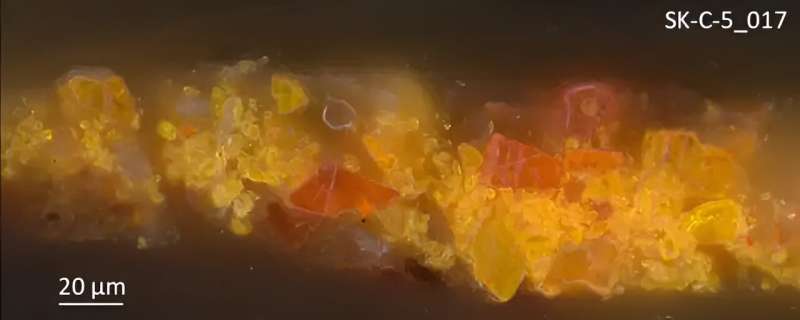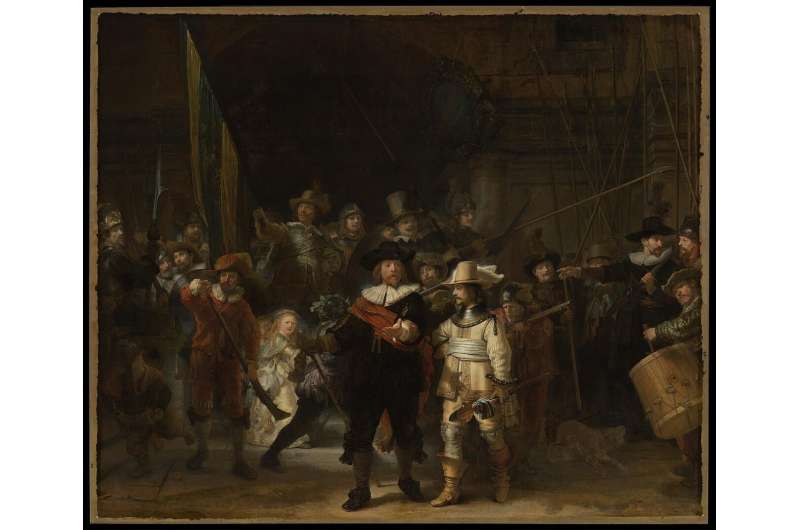This article has been reviewed according to Science X's editorial process and policies. Editors have highlighted the following attributes while ensuring the content's credibility:
fact-checked
trusted source
proofread
Chemists reveal how Rembrandt combined special pigments for golden details of 'The Night Watch'

Chemists at the Rijksmuseum and the University of Amsterdam (UvA) have for the first time established how Rembrandt applied special arsenic sulfide pigments to create a "golden" paint.
Using sophisticated spectroscopic techniques, they were able to map the presence of pararealgar (yellow) and semi-amorphous pararealgar (orange/red) pigments in a striking detail of his famous work "The Night Watch." Corroborated by study of related historical sources, they conclude that Rembrandt intentionally combined these particular arsenic sulfide pigments with other pigments to create the golden luster.
The discovery was published in the journal Heritage Science by Fréderique Broers and Nouchka de Keyser, Ph.D. candidates at the UvA's Van 't Hoff Institute for Molecular Sciences and researchers at the Rijksmuseum.
They conclude that Rembrandt used the rather unusual combination of pigments to depict the golden threading in the doublet sleeves and embroidered buff coat worn by Lieutenant Willem van Ruytenburch. He is on the right of the two central figures at the front of the shooting company tableau, accompanying Captain Frans Banninck Cocq.

Unusual pigments
The discovery of the arsenic sulfide pigments took place in the large-scale research project Operation Night Watch which started in 2019 and continues to deliver striking results. A full X-ray fluorescence (MA-XRF) scan of the painting had already revealed the presence of arsenic and sulfur in parts of Van Ruytenburch's clothing. It led the researchers to assume the presence of the well-known arsenic sulfide pigments orpiment (yellow) and realgar (red).
A detailed study of two tiny paint samples taken from the painting showed otherwise. High-tech analysis combining light microscopy with micro-Raman spectroscopy, electron microscopy and X-ray powder diffraction revealed the presence of the more unusual arsenic sulfide components pararealgar (yellow) and semi-amorphous pararealgar (orange-red).

Deliberate use
The presence of pararealgar in historical paintings is often explained by the aging of realgar. However, because pararealgar is homogeneously distributed with the semi-amorphous pararealgar, and the paint looks unaltered, the researchers arrive at a different explanation.
They argue that Rembrandt deliberately chose to use these pigments in his effort to imitate the golden details of Van Ruytenburch's clothing. Heating yellow pararealgar pigment results in formation of the reddish semi-amorphous pararealgar. This was then combined with lead–tin yellow and vermilion (red mercury sulfide) pigments to create the golden luster.
This chemical explanation was supported by a comprehensive review of historical sources reporting on the use of arsenic sulfide pigments. It seems that in 17th-century Amsterdam a broader range of arsenic pigments were available than previously thought.
These probably arrived through known trade routes from Germany/Austria and Venice to Amsterdam. This is further supported by the reported use of a very similar mixture of pigments by Willem Kalf (1619–1693), a contemporary of Rembrandt in Amsterdam.
The researchers therefore conclude that Rembrandt intentionally used pararealgar and semi-amorphous pararealgar, together with lead–tin yellow and vermilion, to create the special orange-"golden" paint.
More information: Nouchka De Keyser et al, Discovery of pararealgar and semi-amorphous pararealgar in Rembrandt's The Night Watch: analytical study and historical contextualization, Heritage Science (2024). DOI: 10.1186/s40494-024-01350-x
Provided by University of Amsterdam



















